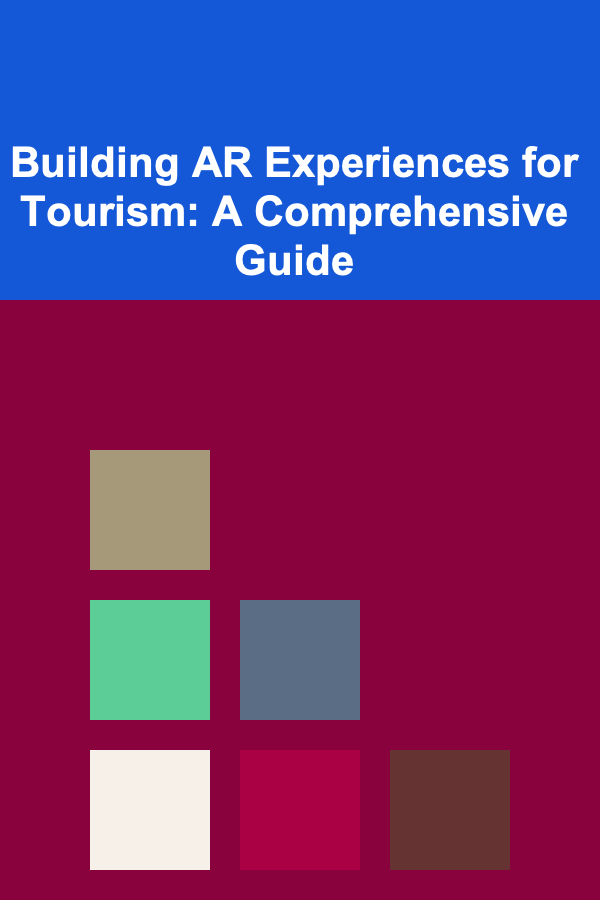
Building AR Experiences for Tourism: A Comprehensive Guide
ebook include PDF & Audio bundle (Micro Guide)
$12.99$7.99
Limited Time Offer! Order within the next:

Augmented Reality (AR) is rapidly transforming the tourism industry, offering innovative ways to engage visitors, enhance their understanding of destinations, and create unforgettable experiences. By overlaying digital content onto the real world, AR can bring historical sites to life, provide interactive maps, offer personalized recommendations, and even gamify exploration. This guide provides a comprehensive overview of how to build compelling AR experiences for tourism, covering everything from initial planning and technology selection to content creation, testing, and deployment.
Understanding the Potential of AR in Tourism
Before diving into the technical aspects of AR development, it's crucial to understand the diverse applications and benefits that AR can bring to the tourism sector. AR goes beyond simply providing information; it offers an immersive and interactive way for tourists to connect with their surroundings.
- Enhanced Historical and Cultural Experiences: AR can reconstruct historical events, showcase ancient artifacts in their original context, and provide in-depth narratives about historical figures and cultural traditions. Imagine standing in front of the Roman Forum and using AR to see a virtual reconstruction of the site as it existed centuries ago.
- Interactive Navigation and Information: AR can overlay maps and directions onto the user's view, making navigation intuitive and effortless. It can also provide real-time information about points of interest, such as opening hours, ticket prices, and user reviews. No more struggling with paper maps or relying on patchy internet connections.
- Gamified Exploration and Engagement: AR can transform sightseeing into a fun and engaging game. Tourists can participate in scavenger hunts, solve puzzles related to historical landmarks, and earn rewards for discovering hidden gems. This approach is particularly effective for attracting younger audiences.
- Personalized Recommendations and Offers: By leveraging location data and user preferences, AR can provide tailored recommendations for restaurants, shops, and activities. It can also offer exclusive discounts and promotions to incentivize exploration and spending.
- Accessibility and Inclusivity: AR applications can provide translations of signage, audio descriptions for visually impaired users, and visual aids for individuals with learning disabilities, creating a more inclusive and accessible tourism experience for everyone.
However, successful AR tourism experiences are not just about technology. They require careful planning, engaging content, and a deep understanding of the target audience. The key is to find the right balance between technological innovation and meaningful storytelling.
Defining Your Target Audience and Goals
The foundation of any successful AR project lies in clearly defining your target audience and establishing specific, measurable, achievable, relevant, and time-bound (SMART) goals. This stage will inform your design choices, content strategy, and overall approach.
2.1 Identifying Your Target Audience
Consider the demographics, interests, and technological literacy of your target audience. Are you targeting families with young children, history buffs, adventure seekers, or luxury travelers? Each group will have different expectations and preferences regarding AR experiences.
- Demographics: Age, gender, location, income level, education.
- Interests: History, art, nature, adventure, food, culture.
- Technological Literacy: Familiarity with smartphones, AR apps, and other technologies.
- Travel Style: Independent travelers, group tours, luxury travel, budget travel.
For example, an AR experience designed for families with young children might focus on interactive games and educational content, while an AR experience for history buffs might prioritize detailed historical reconstructions and in-depth narratives.
2.2 Setting SMART Goals
Clearly defined goals will help you measure the success of your AR experience and guide your development efforts. Examples of SMART goals include:
- Increase tourist engagement by X% at a specific landmark.
- Improve visitor satisfaction scores by Y% based on post-visit surveys.
- Drive Z% more traffic to local businesses through AR-powered recommendations.
- Promote a specific historical narrative to a younger audience.
- Increase the number of users downloading and using the AR app by X within Y months.
Remember to regularly review and adjust your goals as needed based on user feedback and performance data.
Choosing the Right AR Technology
The AR technology landscape is constantly evolving, with a variety of platforms, tools, and frameworks available for developers. Selecting the right technology stack is crucial for building a robust, scalable, and engaging AR experience.
3.1 AR Development Platforms
Consider the following popular AR development platforms:
- ARKit (Apple): A powerful AR framework for iOS devices, offering robust tracking capabilities, scene understanding, and realistic rendering. ARKit is known for its ease of use and strong performance on Apple devices.
- ARCore (Google): Google's AR framework for Android devices, providing similar features to ARKit, including motion tracking, environmental understanding, and light estimation. ARCore supports a wide range of Android devices.
- Vuforia Engine: A cross-platform AR SDK that supports both iOS and Android, known for its advanced object recognition capabilities and ability to track a variety of targets, including images, objects, and environments. Vuforia Engine is a good choice for projects that require complex tracking and object recognition.
- Wikitude: Another cross-platform AR SDK that offers a range of features, including image recognition, object tracking, location-based AR, and SLAM (Simultaneous Localization and Mapping). Wikitude is often used for enterprise-level AR applications.
The choice of platform will depend on your target audience (iOS vs. Android), the features you require (e.g., object recognition, location-based AR), and your budget. Consider the development costs, licensing fees, and ongoing maintenance requirements of each platform.
3.2 AR Techniques and Approaches
Understand the different AR techniques that can be employed to deliver your desired experience:
- Marker-Based AR: Relies on specific images or codes (markers) to trigger AR content. This approach is relatively simple to implement but can be less immersive than markerless AR. Examples include scanning a QR code to unlock an AR experience.
- Markerless AR (Location-Based AR): Uses GPS, Wi-Fi, and other location data to trigger AR content based on the user's position. This approach is ideal for outdoor experiences, such as interactive tours and city exploration.
- Markerless AR (Surface Tracking): Detects and tracks surfaces in the environment to anchor AR content. This approach allows for more realistic and immersive AR experiences, as the content appears to be seamlessly integrated into the real world. Think placing virtual furniture in your living room before buying it.
- Object Recognition AR: Identifies and tracks specific objects in the environment to trigger AR content. This approach is useful for providing information about objects of interest, such as historical artifacts or landmarks.
3.3 Development Tools and Software
Several software tools are essential for building AR experiences:
- Unity: A popular game engine that is widely used for AR development. Unity provides a comprehensive set of tools for creating 3D environments, animations, and interactive elements.
- Unreal Engine: Another powerful game engine that is suitable for creating high-fidelity AR experiences. Unreal Engine offers advanced rendering capabilities and a visual scripting system.
- Blender: A free and open-source 3D modeling and animation software. Blender can be used to create custom 3D assets for your AR experiences.
- Adobe Creative Suite (Photoshop, Illustrator, After Effects): Used for creating 2D graphics, textures, and animations for your AR content.
Familiarity with these tools and a strong understanding of programming concepts are essential for successful AR development. Consider hiring experienced AR developers or investing in training for your existing team.
Creating Engaging AR Content
The success of your AR experience hinges on the quality and relevance of your content. Compelling content will capture the user's attention, enhance their understanding of the destination, and create a memorable experience.
4.1 Storytelling and Narrative
Craft a compelling narrative that resonates with your target audience. Use storytelling techniques to bring historical events to life, reveal hidden stories behind landmarks, and create an emotional connection with the destination. Consider the following:
- Historical Reconstructions: Recreate historical scenes and events using 3D models, animations, and audio narration.
- Character-Driven Stories: Introduce historical figures or fictional characters to guide users through the experience.
- Interactive Narratives: Allow users to make choices that influence the story's outcome.
- Audio Narration and Sound Design: Use professional voice actors and sound effects to create an immersive audio experience.
4.2 3D Modeling and Animation
High-quality 3D models and animations are essential for creating visually appealing AR experiences. Pay attention to detail, realism, and optimization for mobile devices.
- Accurate Recreations: Ensure that 3D models of historical buildings and artifacts are accurate and detailed.
- Optimized Models: Optimize 3D models for mobile devices to ensure smooth performance. Reduce polygon counts and use efficient textures.
- Realistic Animations: Create realistic animations of historical figures and events.
- User Interaction: Design interactive elements that allow users to manipulate 3D models and explore them from different angles.
4.3 Interactive Elements and Gamification
Incorporate interactive elements and gamification mechanics to keep users engaged and motivated. Consider the following:
- Scavenger Hunts: Create AR-powered scavenger hunts that encourage users to explore different locations.
- Puzzles and Challenges: Incorporate puzzles and challenges that require users to solve problems related to historical facts or cultural traditions.
- Rewards and Recognition: Offer rewards and recognition for completing tasks and achieving milestones.
- Leaderboards and Social Sharing: Encourage friendly competition by displaying leaderboards and allowing users to share their progress on social media.
4.4 User Interface (UI) and User Experience (UX) Design
A well-designed UI and UX are crucial for ensuring a seamless and enjoyable AR experience. Keep the interface clean, intuitive, and easy to navigate.
- Clear and Concise Instructions: Provide clear and concise instructions on how to use the AR experience.
- Intuitive Navigation: Design an intuitive navigation system that allows users to easily explore different features and content.
- Contextual Help: Provide contextual help and tooltips to guide users through the experience.
- Accessibility Considerations: Design the UI with accessibility in mind, ensuring that it is usable by people with disabilities.
4.5 Localization and Multilingual Support
If you are targeting international tourists, it's essential to localize your AR experience and provide multilingual support. Translate all text, audio narration, and user interface elements into multiple languages.
Testing and Optimization
Thorough testing and optimization are crucial for ensuring a smooth, reliable, and engaging AR experience. Test your AR experience on a variety of devices and in different environments.
5.1 Usability Testing
Conduct usability testing with real users to identify any issues with the user interface, navigation, or overall user experience. Observe users as they interact with the AR experience and gather feedback on their impressions.
- Recruit Participants: Recruit participants who represent your target audience.
- Test Different Scenarios: Test different scenarios and use cases to ensure that the AR experience works as expected in various situations.
- Gather Feedback: Gather feedback through surveys, interviews, and observation.
- Iterate on Design: Use the feedback to iterate on the design and improve the user experience.
5.2 Performance Testing
Test the performance of your AR experience on different devices to ensure that it runs smoothly and efficiently. Monitor frame rates, memory usage, and battery consumption.
- Test on Different Devices: Test on a variety of devices, including low-end, mid-range, and high-end smartphones and tablets.
- Optimize for Performance: Optimize 3D models, textures, and animations to reduce memory usage and improve performance.
- Monitor Frame Rates: Monitor frame rates to ensure that the AR experience runs smoothly.
- Test Battery Consumption: Test battery consumption to ensure that the AR experience does not drain the battery too quickly.
5.3 Environmental Testing
Test the AR experience in different environments to ensure that it works reliably in various lighting conditions, weather conditions, and geographical locations.
- Test in Different Lighting Conditions: Test in bright sunlight, cloudy weather, and indoor environments.
- Test in Different Weather Conditions: Test in different weather conditions, such as rain, snow, and fog.
- Test in Different Geographical Locations: Test in different geographical locations to ensure that the AR experience works reliably regardless of the user's location.
5.4 Bug Fixing and Optimization
Fix any bugs and optimize the AR experience based on the results of your testing. Address performance issues, usability problems, and environmental challenges.
Deployment and Marketing
Once your AR experience is ready, it's time to deploy it and market it to your target audience. Consider the following strategies:
6.1 App Store Optimization (ASO)
Optimize your app store listing to improve its visibility and attract downloads. Use relevant keywords, write a compelling description, and include high-quality screenshots and videos.
6.2 Social Media Marketing
Promote your AR experience on social media platforms such as Facebook, Instagram, Twitter, and YouTube. Use engaging content, such as videos and images, to showcase the features and benefits of your AR experience.
6.3 Partnerships and Collaborations
Partner with local businesses, tourism organizations, and influencers to promote your AR experience. Offer exclusive discounts and promotions to incentivize users to try your AR experience.
6.4 Public Relations (PR)
Reach out to journalists and bloggers to generate media coverage for your AR experience. Highlight the innovative features and benefits of your AR experience and its potential to transform the tourism industry.
6.5 On-Site Promotion
Promote your AR experience on-site at tourist attractions, hotels, and other locations. Use signage, flyers, and posters to raise awareness of your AR experience.
Ongoing Maintenance and Updates
AR technology is constantly evolving, so it's essential to provide ongoing maintenance and updates to your AR experience. Address bug fixes, optimize performance, and add new features and content based on user feedback and technological advancements.
- Monitor User Feedback: Continuously monitor user feedback through app store reviews, social media comments, and in-app surveys.
- Address Bug Fixes: Promptly address any bug fixes reported by users.
- Optimize Performance: Continuously optimize performance to ensure that the AR experience runs smoothly on a variety of devices.
- Add New Features and Content: Add new features and content based on user feedback and technological advancements.
- Stay Up-to-Date with AR Technology: Stay up-to-date with the latest AR technology and trends.
Ethical Considerations
As with any technology, it's important to consider the ethical implications of AR and ensure that your AR experience is used responsibly. Address issues such as privacy, data security, and accessibility.
- Privacy: Protect user privacy by collecting only the data that is necessary for the AR experience and by being transparent about how the data is used.
- Data Security: Ensure the security of user data by implementing robust security measures.
- Accessibility: Design the AR experience with accessibility in mind, ensuring that it is usable by people with disabilities.
- Accuracy: Ensure that the information presented in the AR experience is accurate and reliable.
- Cultural Sensitivity: Be sensitive to cultural differences and avoid content that could be offensive or disrespectful.
Examples of Successful AR Tourism Experiences
Numerous companies and organizations have successfully implemented AR experiences to enhance tourism. Examining these examples can offer valuable insights and inspiration:
- Timelooper: Offers immersive time travel experiences at historical landmarks, allowing users to see what locations looked like in the past.
- Civilisations AR (BBC): Brings historical artifacts to life in your own home, providing detailed information and interactive elements.
- Rick Steves Audio Europe App with AR Features: Augments existing travel guides with AR capabilities, providing real-time information and points of interest overlays.
By studying these examples, you can identify best practices and learn from the successes and failures of others.
The Future of AR in Tourism
The future of AR in tourism is bright, with continued advancements in technology and increasing adoption by travelers. Expect to see even more immersive, personalized, and engaging AR experiences in the years to come.
- Improved AR Hardware: Advancements in AR glasses and other wearable devices will make AR experiences more seamless and immersive.
- AI-Powered AR: Artificial intelligence will play a greater role in AR, enabling more personalized and contextual experiences.
- 5G Connectivity: Faster and more reliable 5G connectivity will enable more bandwidth-intensive AR experiences.
- Haptic Feedback: Haptic feedback will add a new dimension to AR, allowing users to physically interact with virtual objects.
By staying ahead of the curve and embracing new technologies, you can create truly unforgettable AR experiences that will attract tourists and transform the tourism industry.
Reading More From Our Other Websites
- [Organization Tip 101] How to Establish a System for Incoming Invoices
- [Personal Finance Management 101] How to Create a Budget That Works: Budgeting for Beginners
- [Home Space Saving 101] How to Use Under-Bed Storage to Maximize Bedroom Space
- [Digital Decluttering Tip 101] From Chaos to Calm: Building a Sustainable Digital Decluttering Routine
- [Organization Tip 101] How to Use a Travel Journal to Keep Your Adventures Organized
- [Toy Making Tip 101] Seasonal Toy-Making: Holiday-Themed Crafts for Year-Round Fun
- [Biking 101] How to Maximize Space with the Best Bike Storage Solutions
- [Reading Habit Tip 101] The Inspirational Reading List Every Creative Mind Needs
- [Home Budget 101] How to Save Money on Landscaping and Lawn Care at Home
- [Home Storage Solution 101] How to Organize Your Pantry with Smart Storage Solutions

How to Decorate Your Home with Budget-Friendly DIY Art
Read More
How to Maintain Your Pet's Toys and Accessories
Read More
How to Make a Party Supplies Checklist for a Movie Night Party
Read More
How To Train Your Dog Not to Jump
Read More
How to Use Color-Coding for Effective Organization
Read More
How to Plan Social Media Content for Sustainable Businesses
Read MoreOther Products

How to Decorate Your Home with Budget-Friendly DIY Art
Read More
How to Maintain Your Pet's Toys and Accessories
Read More
How to Make a Party Supplies Checklist for a Movie Night Party
Read More
How To Train Your Dog Not to Jump
Read More
How to Use Color-Coding for Effective Organization
Read More